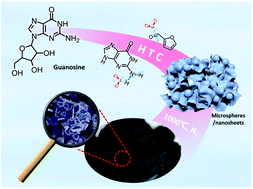Building microsphere–nanosheet structures in N-doped carbon to improve its performance in the oxygen reduction reaction and vanadium redox flow batteries†
Abstract
Presented here is a facile, sustainable and green method for the synthesis of N-doped carbon microspheres/nanosheets via hydrothermal carbonization (HTC) of the selected bioprecursor guanosine. The morphology of such carbons presents a hierarchical microstructure consisting of carbon microspheres and carbon nanosheets with a relatively disordered but mainly sp2 hybridized graphitic structure. Control experiments indicate that the formation of carbon microspheres was mainly related to the HTC process of the ribose component in guanosine, while the carbon nanosheets likely originated because of the self-templating effect of the guanine component in guanosine. This kind of HTC product (Go-HTC-1000) properly compensates for the disadvantages of the ribose-based counterpart (such as a monotonously microporous structure and non-nitrogen doped nature) and the guanine-based counterpart (such as a low specific surface area and low HTC carbon yield), leading to the formation of a completely new carbon with in situ high-level nitrogen doping, moderately defective structure and developed hierarchically porous texture. Owing to such unique morphological and structural features, it is expected to be superior in several catalytic reactions. When representatively used as an electrocatalyst for the oxygen reduction reaction (ORR), it exhibits superior performance with a very positive half-wave potential of 0.850 V (vs. RHE) comparable to that of the Pt/C catalyst (0.855 V) and excellent stability. When serving as an electrode material for vanadium redox reflow batteries (VRFBs), it shows significantly improved performances in both positive and negative reactions compared to pristine graphite felt (GF), performing well at various current densities ranging from 100 mA cm−2 to 500 mA cm−2 and achieving high energy efficiency and good rate performance. The work is believed to inspire a new perspective for the facile but efficient fabrication of novel carbon-based materials with high added values.



 Please wait while we load your content...
Please wait while we load your content...